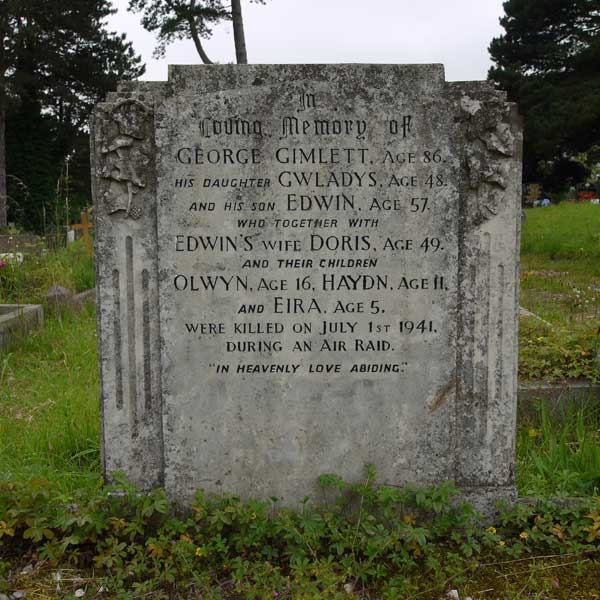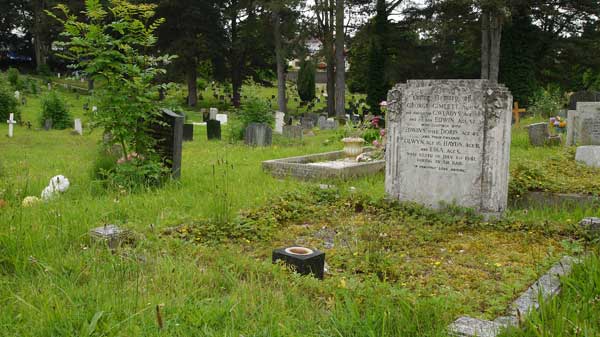St Woolos Cemetery - The Haunted Holy Ground
From the book "The Haunted Holy Ground" by Mike Buckingham and Richard Frame published in 1988.
The Raging Elements - Fire and Air
By Mike Buckingham and Richard Frame
First published 1988
© Mike Buckingham and Richard Frame 2012
The early days of July, when summer should still have some of its freshness, seems to bring only sorrow to Newport. One of our greatest calamities, the caving in of the New Dock, which took the lives of 39 workers, happened on July 2, 1909.
On that day, death came in the form of tons of collapsing earth and flooding water.
Forty-one years later almost to the day air was to be the death-dealing element.
Fire and Air.
Almost on the stroke of midnight the RAF fighter pilot caught sight of the German bomber sneaking low over the Bristol Channel, choosing exactly the right spot at which to drop its cargo of sea mines.
With his guns cocked the fighter went fast and low after the German, who, alerted by the burst of gunfire, turned and ran. The slow bomber was no match for the fast, light fighter, but he might have a chance if he could lighten his load and take advantage of the night to sneak away.
The German crewman pulled the toggle which released the sea mines and instantly the aircraft bucked and sprinted forward through the air, as would a horse that had suddenly become free of its rider.
At that instant, many Newport people — exactly how many people is not known, but it is thought to be over thirty in one street alone - were living their last.
A total of eight sea mines fell that night. One fell in Beechwood Road, Newport, blowing up some houses, and two fell at the docks. At least one fell in the River Usk, another fell in Waterloo Road, one on the home of the Searle family in Kensington Place and another in Eveswell Street.
Edwin Gimlett, who still lives in a quiet part of Newport, remembers that terrible night well. It was the early hours of July 1 which saw his father, grandfather, aunt, brother and sisters dead in the ruins of their home, and his mother mortally injured.
“It was just a week after my 14th birthday and we had been involved in the move from Stow Hill to what is now St. Julian’s High School,” Mr. Gimlett recalls.
“My class had not been allowed time off for the move. The night the mines fell I had been carrying books all day and was dog-tired.
“By the time the sirens went at about midnight, we were all in bed
I shared a room with Haydn, the brother two years younger than me. The sirens were nothing unusual. We assumed it was the bombers going over to attack the Midlands. We did not have an air-raid shelter in our garden although they were in the process of building one in the middle of the street. The drill was that if the gunfire from Belmont House ack-ack guns got a bit loud we would go downstairs.
“My father had been injured in a road accident in the January and was not able to go up the stairs, so he and my mother were in the front room.
“My middle sister, Olwyn, was incompatible with Haydn, so when we went downstairs my mother made me sit in between them on the settee. My grandfather, George, who would have been 87 the next day, was upstairs, as was my aunt.
“Suddenly there was this terrible banging and I remember my mother saying: ‘Some poor souls are having it’.
“Then everything went black. I remember there was something in my mother’s spine which killed her, but which saved me.
“I can remember somebody — it must have been one of the rescue workers — saying: ‘Here’s one of them.’
“I can remember Doctor Christian Balfour Fotheringham, a broad Scot, saying: ‘Lie still, Laddie,’ as he gave me a pain-killer. I remember them getting me out just as some more stuff fell... I don’t know after that.
“I was on a trolley when I came to... I seem to remember something else falling... I don’t know. I have been told that large slabs of the wall were falling all over the place, it must have been that.
“My mother was in St Woolos Hospital the same as me. Apparently we went in the same ambulance.
“I did not know much about this until some ten days later.
“People from the gun sites would visit and tell me that my Mum was coming along fine. It was not until ten days had passed that I found out she was dead. I had a fractured skull and some lesser injuries: I still get minor black-outs as a result.
“The people who died were my mother, Doris, who was 48, my father, Edwin, who was 57, and his father, Mr. George Gimlett, who as I have mentioned would have been 87 the next day.
“My grandfather’s sister, Gladys, who was a maiden aunt, died along with my sister Olwyn, who was 16, Haydn, who was coming on 12 and my little sister, Eira, who was five.

Location: FC D24
“The only people in our house to survive were my older sister, Louise, who was 19, and of course myself. I heard later that 35 people in the street had been killed. It was a terrible thing. The Germans had been mining the Bristol Channel because at that time the docks were stacked with war material coming over from America.”
The fire station at Maindee and some prefabs now mark the spot where the bomb fell that night.
There is a personal interest in this story for Richard, quite apart from his wanting to record it between the covers of this book.
Next door to the stricken Gimletts lived the Rudges, Mr Haydn Rudge being the father of Richard’s wife, Sue.
On that fateful night, Haydn was sleeping in the bath because his aunt was in the bed. Having been awoken by the sirens, he looked out of the window to see a parachute drifting downwards, and as it neared the ground he ran back and pulled the blankets over his head, since the 12-year-old boy knew that mines were usually dropped with small parachutes to regulate the speed of their descent.
Haydn, who has since died, would tell for years afterwards how there was a terrific explosion and the window blew in on him sending lethal shards of broken glass flying across the room like shrapnel.
All the Rudges were safe, but it was only when they had made their way out into the street they learned of the tragedy that had befallen their neighbours.
The Gimlett grave is a simple, dignified affair, and Richard says that every time he sees it he feels personally touched.
“The people who are buried there were the friends and neighbours of my wife’s family and I feel a connection with them, but there is something else about the grave that makes me sad.
“I suppose that in building up the story of St Woolos and its occupants you get used to seeing families whose members died through natural causes; disease, or just old age.
“But this was different. On that terrible night instant death fell upon innocent people quite literally like a bolt from the blue.”

Terry Underwood, Newport businessman and publisher, has his own story to tell of that night.
“I had been playing billiards the night before — I was only 13 but a bit of a lad in those days — and was still at the friend’s home in Corporation Road when the sirens went, although I was so engrossed in the game I did not hear them.
“Suddenly there was a violent shaking of the house and I went like a rocket from there. I had been told by my parents to head for home when I heard the sirens.
“I ran from Corporation Road with glass from shop windows shattering all around me. It was really weird: it looked as though an invisible giant was rampaging along the street.
“I ran into our house at Lennard Street and my parents were already in the air raid shelter at the back. After a screaming match we settled down for the night. The next morning the buzz was that had it not been for the railway embankment we would have been devastated because Eveswell Street, Archibald Street and the places that got it worst were just on the other side of the embankment.
“Early next morning, I put on my scout uniform and told my mother I was going round to see what I could do to help.
“My first view of the devastation was through the tunnel which leads from ‘The Potteries’ (Soho Street). There was a crowd of people at the other end, and a barrier.
“I told a policeman why I was there and what I intended to do and he told me to come on through and go to the Red Shield van where some other boys were already helping with the work; dealing out tea and biscuits to the rescuers.
“I had to work hard to keep my mind off the scene around me. It seemed to me that the world had ended. All the roofs were off the houses and walls were exposed, wallpaper was dangling off walls. My most vivid memory was a piano on top of a pile of rubble, its insides shattered and strings hanging out.
“They were pulling out bodies at that stage — it was the first time I had ever seen a dead body and I wanted to look away. Within an hour of being there I was filthy with all the dirt, the bricks and the mortar.
“The whole area was crawling with troops and police. There was a strange air of unreality about the whole thing.
“These were streets I had known since very earliest childhood and in which I had played.
“Before the war I used to ride horses at what we used to call ‘Clarkie’s field’ now the site of STC.
“In those happy and carefree days before the war it would have been impossible to even imagine the horror that fell from the sky that night.
“The list of the dead was posted in a paper shop in Wharf Road. There was a perpetual small crowd around this shop. Thirty-seven people died all told, with 42 seriously injured.
“And yet the strange thing is by that same afternoon a sense of humour had returned to the scene: I know how strange that must sound.
“But I quite distinctly remember a rescue worker as black as a coal miner who climbed a pile of rubble, found and old stool, put it in front of the gutted piano and said: ‘Right, fellas, what do you want to hear?”
‘There was nervous laughter. It seemed that some of the tension was being released.”